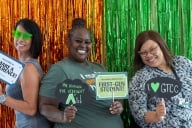You have /5 articles left.
Sign up for a free account or log in.

A mentoring initiative from Elon University seeks to empower all campus community members to invest in intentional relationship-building.
Fresh Splash/E+/Getty Images
Research shows students who have at least one connection to campus are more likely to persist, retain and complete a college degree, particularly students from historically marginalized or less privileged backgrounds. Students who feel connected to their institution are also more likely to have better mental well-being, as well.
Mentorship is one way colleges and universities facilitate intentional relationship-building, but not every student has someone they can turn to for support while at college. A 2021 Student Voice survey by Inside Higher Ed, conducted by College Pulse, found nearly half of students couldn’t identify a mentor who could give them advice on navigating college and planning for after college.
An additional challenge is preparing faculty and staff members to serve as part of a student’s support system, because some campus community members feel less confident in their role as a mentor.
In this episode of Voices of Student Success, host Ashley Mowreader speaks with Elon University’s Peter Felten, executive director of the Center for Engaged Learning, and Emily Krechel, director of new student programs. Felten and Krechel serve as members on the Mentoring Initiatives Design Team. The two discuss the role of relationships in student success and how Elon stakeholders look to create a relationship-rich university community.
An edited version of the podcast appears below.
Inside Higher Ed: Peter, you’ve done a lot of work around relationships in higher ed. Can you paint a broad picture about the role of mentorship, and these relationships in student success in general?
Felten: There’s decades and decades and decades of research that says the quality of relationships students form with peers, with staff and with faculty are really foundational for their learning, their well-being, their sense of belonging, their persistence, their success—all the good stuff that happens with undergraduate education. We’ve known that for decades and decades.
What we’re trying to do at Elon, and a lot of institutions are trying to do the same sort of thing, is create really relationship-rich environments where students can connect with lots of different people in lots of different ways, in the classroom and outside the classroom, so that they have the kind of connections, and the kind of supports that are going to support them in thriving.
Inside Higher Ed: Emily, you work with first-year students, specifically. How do mentorship and relationships play into the first year and that transitional period?
Krechel: What we’ve noticed is that, when students start to form relationships early, they’ve discovered they have a greater connection, not just to the institution, but to the environment that they’re within. They feel a part of the community.
I know different people have different feelings around the term “sense of belonging,” but really it’s that sense of connection that helps students feel like, “I can thrive here.”
So the sooner that we can help students create connections, not just with their peers, but with all those staff and faculty and peer leaders or peer mentors, the quicker we can do that and help them establish a foundation of community, the quicker that students are going to feel adjusted and transitioned into the institution, which leads to higher retention rates, or at least students thinking, “I can stick it out, I’m going to keep trying, I’m going to keep going because I have one friend, or I’ve connected with this staff member. I feel connected to my faculty, my classrooms, so they’re inspiring me to feel a sense of ownership of my experience, but also this connection to my community, and thus the institution and wanting to persist.”
Inside Higher Ed: It sounds like a really simple scenario: We just need students to meet people and like them and feel like they belong somewhere. But it’s not so simple. What are some of those barriers; what are the things that hinder student relationships and connections?
Krechel: That’s a great question, and it’s something that I think every institution is trying to figure out—how do we reduce the barriers to those connections? I think it’s about creating pathways.
Working in orientation, what can we do during orientation that helps inspire students to connect? And that is changing, and how orientation professionals do that work. If you look at the different research on students today, they don’t necessarily want to be programmed anymore, so these formal get-to-know-you programs, or you’re telling me what to do, that’s not necessarily the best move for an institution to help them build community. Rather, creating these informal experiences where students can be side by side, engaging in an activity that they have thus chosen to do.
We do in our orientation program a lot of social programming in which, here are multiple options, choose what you would like to engage in, or choose to just hang out and play games or hang out and talk. What we want you to do is just come out of your room, as opposed to just being a recluse and staying indoors; come out and at least engage and [try] to do multiple different types of activities. Things for those really extroverted people to do, to video games or esports opportunities or board games. Things that are going to be in a loud environment, and things that are going to be more in a personal, small group environment. Trying to cater to multiple different styles of engagement for our students and creating those spaces and places, that’s one way that we’ve tried to do it.
I think those connection points have been lost in students’ experiences over the last couple of years because of COVID and telling people to stay indoors, to not engage with other people. How do we kind of re-establish people’s skill sets around, how do I make friends? How do I go up to somebody new and introduce myself?
One other method that we do specifically in orientation is work with orientation leaders to help them see themselves as those bridge builders and give them the skill set to say, “When you put on your orientation leader shirt, you are basically imbued with a superpower of connection.” People are expecting you to connect with them and go up and introduce yourself to them. They’re like, “Oh, that’s just what an OL [orientation leader] does.” It helps, for them, remove some of the barriers that “maybe I’m shy, maybe that’s just not who I am. I hate networking.” But then I put on this OLK shirt, and I enter in this peer leader role, and I now feel more empowered to engage students and then thus help them connect and build bridges with one another. So kind of tackling it from multiple angles at the early stages in the student’s journey.
Felten: One of the barriers I see in the research, and in the research colleagues and I have done interviewing students around the country, especially [among] first-generation college students, is this sense that everybody else knows how to do college, everybody else has it figured out, and I’m alone in struggling. I’m alone in feeling like I’m not sure if I fit. I’m not sure how to do these things.
When you feel like that, when you feel like you’re alone, like everybody else has figured out, sometimes you feel like an impostor. What you’re most likely to do is isolate yourself even more. You’re never going to admit to people that you’re an impostor, right? So what you do is you stay disconnected. You don’t ask for help; you don’t connect with professors or with peers or staff or anything like this.
This is a barrier we see really strongly, especially in first-gen students. I think one of the things we need to do—whether it’s through an orientation like Emily coordinates at Elon for residential students, or it’s at a community college where none of the students live on campus—is help students recognize that it’s normal, it’s regular to have questions, to have doubts, to have concerns, and that successful students have appropriate help-seeking behaviors. Successful students take the risk to connect with a peer and say hi to somebody or something like that. That’s not a sign that you’re doing it wrong. That’s a sign that you’re going to be successful.
Inside Higher Ed: We see equity gaps in mentorship, specifically where students … have never had a formal mentor in their lives. I wonder if we could talk about that iteration of belonging and connection as well, finding that older mentor, peer, faculty, staff member who you want to connect with and not really knowing how to navigate that situation.
Felten: One of the things we’re trying to do at Elon—and I think lots of institutions are trying to do—is create this environment where students have lots of connections and lots of relationships. We know that a program can assign the student to mentor, Emily is now my mentor, and sometimes that works well, but real mentoring relationships are more organic than that. They’re more human than that. The best thing we can do is create lots of connections and then encourage everybody to try to move them into mentoring.
But we need to recognize that often students whose parents went to university or something like this, have expectations that this is what’s going to happen. First-generation students often have gotten to higher education because they’re so good at working on their own. They’ve often internalized this message that what you need to do to be successful in college is to work on your own. They don’t often seek out relationships, because they don’t value them. And it’s not that there’s something wrong with the students, it’s because they’re so persistent and so successful working individually.
I think the first thing we need to do is teach all our students, help all our students understand that relationships and mentors are going to help you succeed. They’re going to help you thrive academically and personally. And then we have to help teach them strategies. As a professor, I say come to office hours, and only until I had a child at college, and she’s like, “How do you do office hours?” did it occur to me that students might not know what it means to go to office hours.
Finally, I think we have to help students be brave enough to do this. We can offer them all these opportunities, but just as a human, it’s scary sometimes to go to that office and actually knock on the door. So helping them value relationships and mentors, understand some strategies and then develop the courage to actually act.
Krechel: I’ll go a step further and talk a little more about the Mentoring Design Team here at Elon.
We created a framework entitled Mentoring and Meaningful Relationships, where we define seven relationships that students, faculty and staff can have or be [in] one of those relationships. Maybe I’m a teacher, I’m an adviser, I’m a supervisor. How do we help folks apply mentoring skills to all of those different relationships?
Mentoring is happening across meaningful relationships. We often think about, [a] mentor is this one individual who is the penultimate goal of a relationship, in which I’m going to feel like they are changing my life in some way, shape or form. It’s this thing that I’m striving for. Whereas, if we look at meaningful relationships across the board and helping folks establish some mentoring skill sets in which they can apply them, then everyone benefits across the board. Recognizing that different types of relationships, mentoring can exist in some way, shape or form, and helping folks see themselves as a potential mentor for not just students, but also staff and faculty on our campuses.
So that person who is cleaning the library at night when students are studying, who stops and says, “Hey, how’s it going?” to students, they can see themselves building meaningful relationships and creating an environment that is relationship-rich, where students feel seen, they feel like people care about them, no matter the role in which they’re engaging with another human on campus, that everyone on campus buys in to this idea that we’re creating a relationship-rich environment in which I can apply mentoring to all of the different relationships that I have with students and my colleagues as well.
Inside Higher Ed: I love the idea that mentorship isn’t a one-to-one relationship. It’s a cohort, it’s a community, it’s everybody looking to improve their fellow community member. I wonder if you can speak about the tenets of good mentorship. What does it mean to be a good mentor to students, in this idea that anybody and everybody should be mentoring?
Felten: One of the concepts we use at Elon quite a lot comes from a scholar, Brad Johnson, who writes about mentoring, and he talks about what students need, and what humans need is not a single mentor, but a constellation of mentors, a set of people who can support them and challenge them in different ways. And Brad’s research shows that that’s what people tend to have instead of single mentor.
But he also shows that, actually, that’s liberating. It’s empowering for mentors, because then, as a faculty member, if I’m working with a student in undergraduate research, I don’t have to be all things to this student. I am their undergraduate research mentor, and I can support them in professional development and in thinking about themselves as a student and as a person, but they might have aspects of their lives that are far beyond my expertise or my knowledge, and I’m not the right person to be their mentor there. So helping students and helping all of us see that single mentoring relationships are good, but even more powerful as a constellation, [that] can be really helpful for everybody involved.
Krechel: To help folks work on the skills related to mentoring, we created four foundational competencies that can be utilized to create trainings, to create experiences for students and peer leaders, peer mentors, staff and faculty mentors, or just anybody who is interested in bolstering their mentoring skill set.
We created these four foundational competencies, the first one being cultivating empowered relationships with others. Thinking about, how am I actively listening? How do I build those skill sets? How am I working with folks to help them solve problems, help them reflect, clarifying the information they’re sharing with me to make sure I fully understand and helping? Then finding the solutions in those relationships.
The second one is supporting growth and learning. How do I help somebody set goals? How do I give feedback in an effective way?
The third one is developing a critical consciousness: emotional intelligence, self-awareness, understanding my implicit biases so I can engage more effectively in these relationships.
The last one is enhancing your own interpersonal skills. How do I make sure that I can be clear in my communication? How can I have intentionality within my interactions with people, the networking skill sets? How do I make sure that I have the ability to build trust in a relationship?
Those four skill sets help us establish a foundation of workshops. We did a LinkedIn learning pathway in which … we curated three different videos in each of those sections, where we had a pilot program with staff and faculty, where they went in and watched these videos in LinkedIn Learning to develop those skill sets. Then we had communities of practices in which they then engaged with one another to talk about the skill sets that they were learning and the videos that they were learning.
They found it really meaningful, both to watch the videos and be able to do that in their own time, but then have the ability to come together and have a discussion about things that they were having challenges with, whether that was around giving feedback—that was a hot topic. How do I give effective feedback?
Or, “I’m trying to work with this student and really empower them to work through this conflict scenario, and I don’t know if I’m being most effective.” So receiving feedback from their peers on how to do that more effectively, being able to define these four buckets and then have multiple skill sets underneath them, have really helped us think about how we might curate staff and faculty training, but also peer leader training, peer mentor training, which I think is essential because students are connecting with their peers more than they’re going to connect with faculty and staff.
So how can we help peers of students and figure out what are those skill sets that I need to then, maybe even be a more effective friend? Maybe I’m not their big [sister] in a sorority or a leader in a student organization, but this is my friend who is struggling, and so how can I apply some of these mentoring skill sets to help them work through this situation? I think that took us a little bit of time to define those four buckets, but we started with defining the key skill sets that I kind of talked about in each of those and then we themed them into those four competency areas.
Inside Higher Ed: The faculty and staff role has grown over the past decade-plus to include a lot of different things, and one of those is caring for students. Some will feel very drained by that, like, “This is a lot, I’m being asked to do more with less.” What kind of encouragement or advice would you share with somebody who’s like, “I want to do this, but I just don’t know how I can do that on top of everything else”?
Felten: This is such an important question, because we can’t just burn up staff and faculty in the service of student success. We need to have faculty, staff and student success.
There’s a wonderful new book by a scholar at the University of Wisconsin [at Madison], Xueli Wang, called Delivering Promise, and she says, “We need to be students first and educators first.”
I think the first thing I’d say to my faculty colleagues is that, how you teach can connect students with each other and with others at the university in really powerful ways. The connections don’t all have to be with you. Again, you can create an environment, you can create a set of relationships among peers that are really educationally purposeful and also emotionally supportive just in your teaching. That’s thing one: It doesn’t have to be one-on-one.
The second thing is, I think too often, faculty don’t fully understand all the resources at the university that can support students. It’s difficult if a student is in your office and they’re upset, they’re worried where their next meal is going to come from, or where they’re going to sleep tonight, or about a family member’s mental health or something like this. That’s really hard. That is also not your responsibility as a faculty member to solve.
But almost every college or university has staff and resources to do that work. So how do I help my students connect with those resources so that they can get the support they need, so they can thrive in my class? Because if we see this as entirely on us as individuals to do all of the work, we’re not going to be able to support our students very well because we don’t have enough expertise and enough resources, and we’re just going to burn ourselves out.
Krechel: Absolutely. That’s definitely a piece of feedback we heard loud and clear from our staff when we were looking into this more … that few people are feeling, “You’re asking me to do more” when, in fact, we’re not asking folks to do more. We’re just asking them to apply these mentoring skill sets to their everyday work. Ninety-five percent of people on a college campus are working with people. And so how can we apply these things to our colleagues? If I’m working in an advancement office, to the donors that I’m trying to engage, if I work in admissions to the prospective students and their families?
Felten: Emily reminded me of one of the studies … related to faculty, but I think it’s really powerful for all of us to think about in higher education. It’s from scholars at Arizona State University. The question in this paper is, does it matter if professors in very large enrollment first-year biology courses know students’ names?
What they find is that what matters is that students believe the professor cares to know their name. When a student believes the professor in the course cares to know their name, the student’s more likely to persist through struggle. They’re more likely to ask for help. They’re more likely to be successful in the course. This doesn’t turn F students into A students, but it’s a small thing, and it’s also an attainable thing. Because I don’t have to memorize 400 students’ names, but I can convey to my students that they matter to me as individuals, that I want to support and challenge them, and I think any of us in any role can do that same sort of thing, create that sort of environment where students feel welcomed enough that they’re willing to take a risk and ask for help.
Inside Higher Ed: It’s not about getting it right 100 percent of the time, it’s about trying to get it right 100 percent of the time.
Felten: And having students recognize that you’re trying and we all try.
Inside Higher Ed: I want to learn more about what’s going on at Elon with mentoring. We’ve talked a little bit about some of the different work and initiatives you’re both leading, but tell me what else is happening on campus.
Krechel: Through the work of the Mentoring Design Team, we recognize that mentoring is happening in a lot of different places across campus, whether it’s this small peer-to-peer mentor program in a specific department all the way through research with a faculty mentor; it’s happening everywhere. I think what we are now trying to do is harness that energy and create a shared language and shared understanding of what that means and how that can happen on our campus.
The Mentoring Design Team … worked for two years to uncover where mentoring is happening across campus, uncover where meaningful relationships are being established and cultivated and nurtured, to then be able to launch some pilot work.
We had some pilots last year, which explored different pathways to mentoring. We had a mentorship program called Phoenix Mentors; it was designed for first-year students who were— One of the metrics in our retention data is that students who don’t have anyone else from their high school attending Elon are less likely to be retained at Elon. So we were targeting that student population to help, very intentionally, connect them with an upper-class student leader.
We created mentoring learning outcomes in the first-year experience. We had a graduate student pilot doing this type of work within their graduate student orientation programs.
One of the big things is thinking about the infrastructure. We had a teacher-scholar statement for our faculty, which talked about the ethos of what it means to be a faculty member at Elon. This is a statement that faculty really buy in to and really dictates how they are engaging with students and with each other, and how they’re approaching their teaching in the classrooms and outside the classroom. It said “mentoring” in multiple places. And a lot of people actually refer to it as the teacher-scholar-mentor statement, but it was not the teacher-scholar-mentor statement when you looked at it online; it was the teacher-scholar statement.
This is something that faculty use in their unit ones and their P and T [promotion and tenure], and so the Academic Council actually worked with a subset of our committee to make that officially the Teacher-Scholar-Mentor Statement. We’re looking at other places where we can shift infrastructure, or just how we go about doing things, the culture of our campus.
After two years of work with the Mentoring Design Team, we wrote a report, which had numerous recommendations, specifically thinking about, how do we shift culture, how do we create an infrastructure that can sustain this mentoring and meaningful relationships work? Currently that report is sitting with our president and our provost, who are continuing to look through what is the feasibility of this, and where can we start? They are identifying the path forward with that report of this juncture.
But that doesn’t mean the work has stopped. Like I said, mentoring and meaningful relationship work is already here. We just created a framework to help define that more clearly, and there’s advocacy work to continue creating additional pathways and a different additional capacity across the institution to continue deepening that work that is already happening.
Inside Higher Ed: What’s something that you’re looking forward to with this next evolution of mentorship at Elon?
Krechel: A shared language. When I think mentoring, everyone has their own definition of mentoring. And there is in the scholarship definitions of what mentoring is. We, a small group of faculty and staff, did the ACE study in which they defined mentoring. Different people don’t see themselves within those definitions, though, and that’s why we looked at a more broad framework that defined mentoring and meaningful relationships with seven different relationships, where we can hopefully have folks see themselves more clearly in the work and how they fit into it, so we can have a culture across the institution where everyone feels like, “This is a part of my job. This is a part of what I do at Elon. This is just what Elon is.” It’s where everyone feels like they can cultivate and enhance environment that is rich with collegiality, rich with relationships that are intentional and meaningful for both students and then the faculty and staff as well.
Felten: Yes, and helping our students understand that they have agency in this, and they’re absolutely essential in building those kinds of meaningful relationships with faculty, with staff and with peers. Because I think sometimes students aren’t sure you know what to do, aren’t quite confident how to do college. So how do we help them see that they really have a huge role to play in making their own education really powerful and really connected like this, but also their peers? And actually, they can help me as a professor, make this class better by engaging more deeply in all this. And they can help Emily make orientation better by contributing, whether they’re an orientation leader or just a regular student.
I think the more we all see that connections and relationships are at the heart of education, the easier it is for all of us to make those kinds of connections, to do our work and to be well as we’re doing it.








